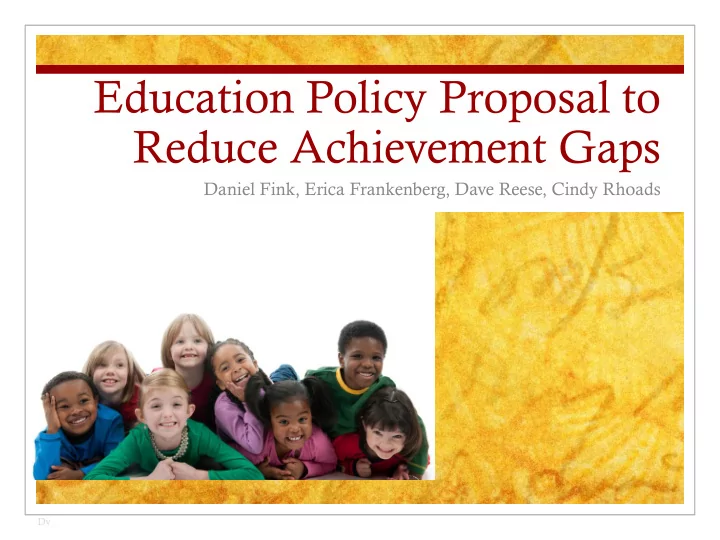

Education Policy Proposal to Reduce Achievement Gaps Daniel Fink, Erica Frankenberg, Dave Reese, Cindy Rhoads Dv
Question More Establish a charter Hire more State funded mentor schools? tutors? teachers? Smaller program? class size? What are appropriate state interventions for struggling school districts, schools, and students in order to promote improved student performance and to eliminate achievement gaps under the requirements of federal and state guidelines? 2 Dv
Our Answer Invest now for a bright Start early! future! The most cost-effective way to address the achievement gap in Pennsylvania is to provide greater access to high-quality early childhood education for children between the ages of 2 and 5. 3 Dv
Outline of Presentation Current situation in Pennsylvania Rationale for proposal How to pay for proposal Conclusion 4 Dv
Current situation Exposed to 3 or more A substantial percentage of risk factors Pennsylvania’s youngest residents are already at risk before they begin kindergarten. Exposed to at least 40% of PA young children live in low- 1 risk factor income households single-parent household, household below the poverty line parents with less than a high school education parents unemployed 5 Dv
What does this mean for schooling? Growing up in low-income households disadvantages students in terms of school readiness. Rothstein (2004) notes the dramatic difference in the vocabulary acquisition of children depending on their family’s social class Seventy percent of Pennsylvania’s counties are recognized as having at-risk populations, which puts considerable burden on these counties’ schools 6 Dv
Current status of pre-K Nationally, the number of students in state-funded preschool programs has grown 70% over the last decade Two-thirds of pre-K students are in public schools One- third of Pennsylvania’s pre -K eligible students were enrolled in early childhood programs At the beginning of the 2010-11 school year, 7,000 children were on a waiting list The continued economic downturn likely has increased the number of at-risk young children and the lack of budget increase will not meet the demand 7 for these programs E
Gap before kindergarten The achievement gap begins to form as early as 18 months A combination of factors prevent at-risk children from receiving the kind of educational nurturing and brain development that will equip them with the necessary basic reading and writing skills or the ability to begin thinking creatively As a result, these students enter kindergarten behind their peers, a gap that may only grow over time 8 E
Rationale: Short-term student outcomes High-quality early education programs can reduce the number of students in elementary school with IEPs Vast majority of students in PA’s high -quality early education programs display age-appropriate academic skills as they enter kindergarten PA’s early education programs are successful in helping at-risk students to build academic and social skills This may help at-risk students close the gap as they enter kindergarten with more affluent children who have developed these skills 9 E
Rationale: Long-term student outcomes Graduating from high school and matriculating in higher education — areas in which there are stubborn discrepancies between the outcomes of white, affluent young adults and lower-income students of color. New study finds participants in Harrisburg Preschool Program, which serves at-risk students, have higher math and reading PSSA scores as fourth-graders than peers who did not participate in the program 10 E
Rationale: Benefits to communities Investment in pre-K returns $7 for every $1 spent Savings include reduced need for government spending on: remediation, special education, welfare assistance, crime prevention Likely to bring increased earnings (and tax revenue) for children when they are adults due to higher educational attainment 11 E
Our proposal Expand access through optional county add- on sales tax = 1% Incentive: 50% County General Fund 50% Early Childhood Education programs 12 Da
How the tax would work Counties would have to opt in. 1% add-on sales tax would use the same base as the Pennsylvania sales tax. Exemptions for necessities such as food, clothing, and prescriptions would make it more of a progressive tax. Offers counties a new revenue source and help counties potentially reduce property taxes. 13 Da
Estimated tax revenues The County Commissioners Association of Pennsylvania estimated that counties would collect a total of $551 million through the add-on tax, if all counties opted in. In York County, that would mean a revenue stream of $21 million. This would be in addition to the current budget proposal, which includes $198 million for Early Intervention, $83.6 million for Pre-K Counts & $37.7 million for Head Start Supplemental Assistance. 14 Da
Where the money would go The 50 percent of the tax for pre-K would be dedicated to expanding existing high-quality early education programs, providing salaries for the additional high-quality teachers, and offering more subsidies to eligible families to enroll their children in the programs. Each county would be responsible for identifying the successful high-quality local programs worth expanding and developing the necessary number of trained teachers 15 Da
Implications for access and capacity United Way of York County: $20 million required for high-quality education for 100 percent of York County children younger than age 5 Implementation could generate $10.5 million for early childhood education. Investment could increase high-quality early education programs from 27 percent to 50 percent of York County pre-school children, effectively doubling the access. 16 Dv
Conclusion Pennsylvania faces tremendous challenges regarding its K-12 public education. It is clear from the evidence that closing the achievement gap early results in increased high school graduation rates, and greater potential for students to pursue further education at technical schools, colleges and universities. A minimal investment at the pre-K level provides exponential returns in achieving responsible, educated adults 17 Dv
Start early! Invest now for a bright future! Questions? Comments? Dv
Recommend
More recommend